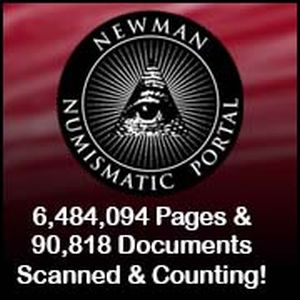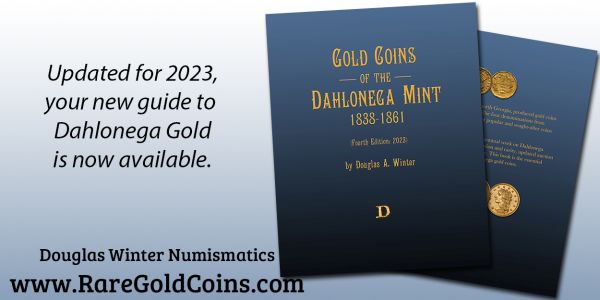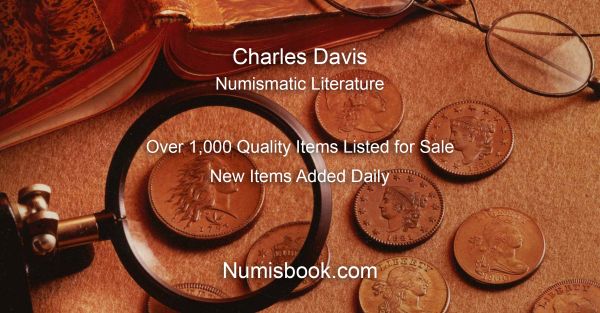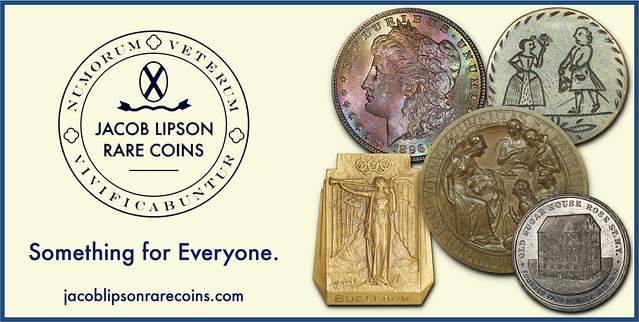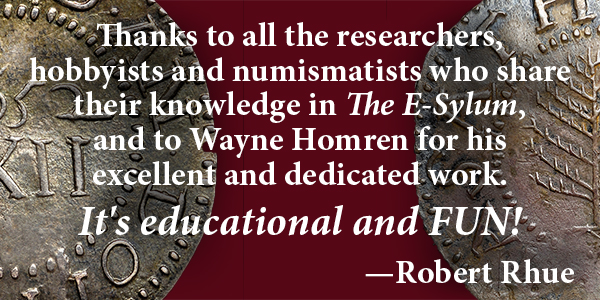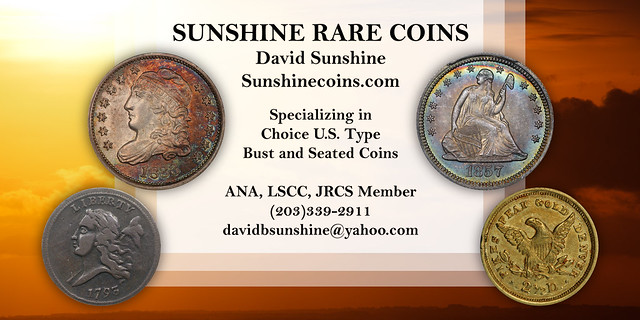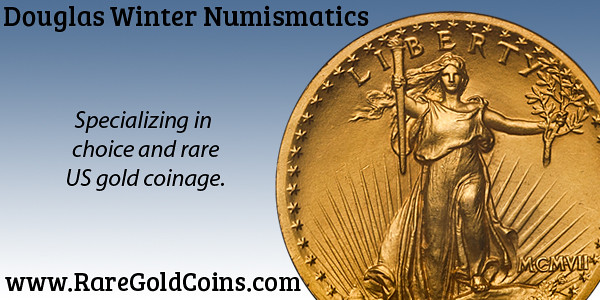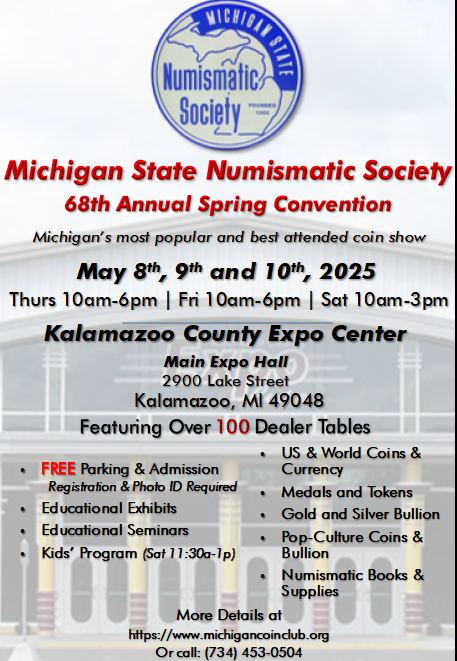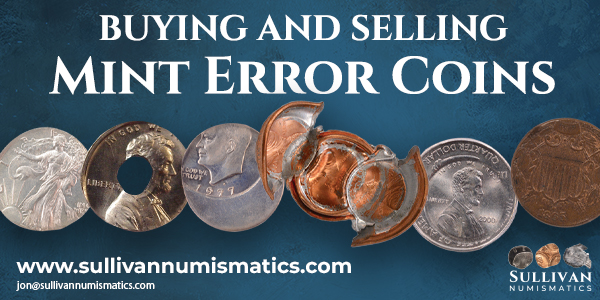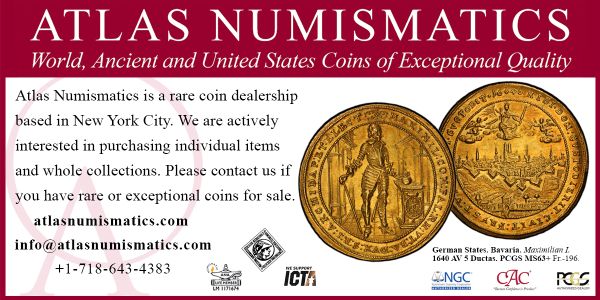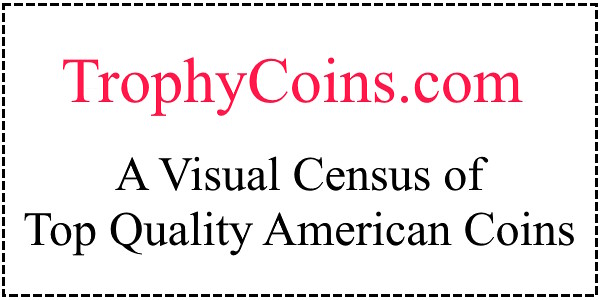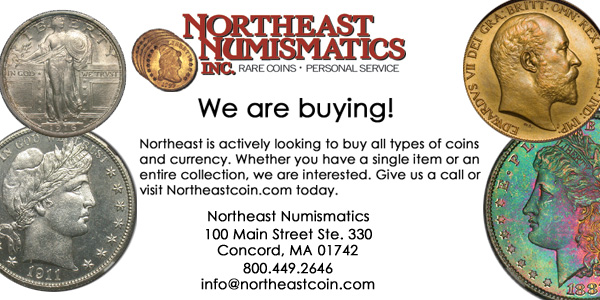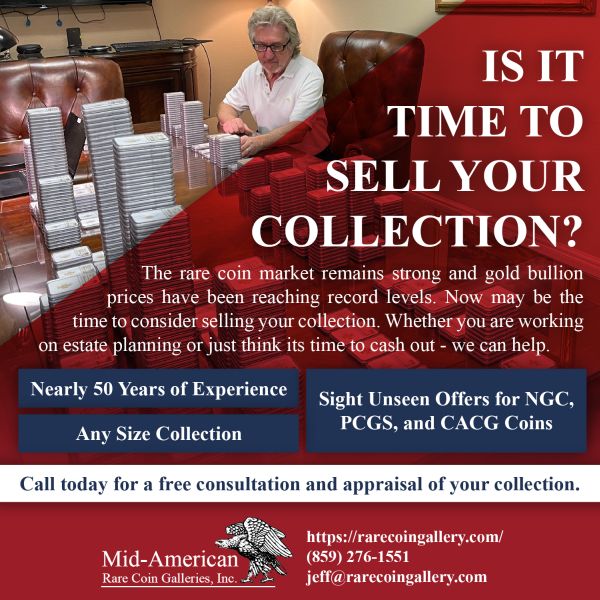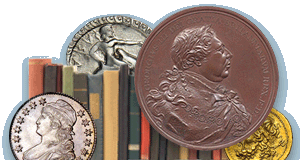
Visit our NBS Sponsors


About UsThe Numismatic Bibliomania Society is a non-profit association devoted to the study and enjoyment of numismatic literature. For more information please see our web site at coinbooks.org SubscriptionsThose wishing to become new E-Sylum subscribers (or wishing to Unsubscribe) can go to the following web page link MembershipThere is a membership application available on the web site Membership Application To join, print the application and return it with your check to the address printed on the application. Print/Digital membership is $40 to addresses in the U.S., and $60 elsewhere. A digital-only membership is available for $25. For those without web access, write to: Jeff Dickerson, Treasurer AsylumFor Asylum mailing address changes and other membership questions, contact Jeff at this email address: treasurer@coinbooks.org SubmissionsTo submit items for publication in The E-Sylum, write to the Editor at this address: whomren@gmail.com BUY THE BOOK BEFORE THE COINSale CalendarWatch here for updates! |
- WAYNE'S WORDS: THE E-SYLUM APRIL 13, 2025
- NEW BOOK: CELTIC COIN ARTICLES
- NEW BOOK: THE ARDHA-MASAKAS
- NEW BOOK: BANKNOTES OF EQUATORIAL AFRICA
- NNP ADDS SHORT SNORTER MONOGRAPH
- VIDEO: CALIFORNIA'S GOLD RUSH ERA MONEY
- 2025 NNP SYMPOSIUM SPEAKERS
- NOTES FROM E-SYLUM READERS: APRIL 13, 2025
- RUSTY GOE SPEAKS ON THE CARSON CITY MINT
- DAHLONEGA MINT DOOR KNOCKER DONATED
- BOSTON MUSEUM OF AMERICAN FINANCE OPENS
- THE 2025 TRIAL OF THE PYX EXPERIENCE
- NUMISMASTER'S 2025 LONDON AND WALES TOUR
- VOCABULARY TERM: REPLACEMENT MEDAL
- MILTON WALDO HANCHETT (1822-1904)
- TREASURE TALK WITH BOB EVANS, EPISODE 3.1
- THE ARIZONA TERRITORIAL MINT
- HERITAGE AUCTIONS: BUST COINAGE
- SANTINI COLLECTION OF RENAISSANCE MEDALS
- EARLY AMERICAN HISTORY AUCTION APRIL 19, 2025
- NICOLAS MAIER MEDAL COLLECTION SELECTIONS
- HUNTINGTON COLLECTION TO BE SOLD AGAIN
- THE MARYLAND GUNPOWDER NOTES
- AUSTRALIAN MONARCHISTS WANT CHARLES NOTE
- WWII POLAND COUNTERFEITING PLATE FOUND
- SLABBING MISCUE: PRUSMACK VS. J.S.G. BOGGS
- LOOSE CHANGE: APRIL 13, 2025
- THROWING BANKNOTES IS ASSAULT
- FEATURED WEBSITE: ARIZONA TERRITORIAL MINT
- ABOUT THIS ISSUE: APRIL 13, 2025
Content presented in The E-Sylum is not necessarily researched or independently fact-checked, and views expressed do not necessarily represent those of the Numismatic Bibliomania Society.
WAYNE'S WORDS: THE E-SYLUM APRIL 13, 2025
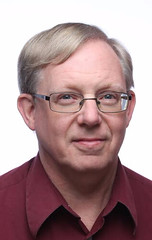 New subscribers this week include:
Eugene Minyailo.
Welcome aboard! We now have 7,258 subscribers.
New subscribers this week include:
Eugene Minyailo.
Welcome aboard! We now have 7,258 subscribers.
Thank you for reading The E-Sylum. If you enjoy it, please send me the email addresses of friends you think may enjoy it as well and I'll send them a subscription. Contact me at whomren@gmail.com anytime regarding your subscription, or questions, comments or suggestions about our content.
This week we open with three new books, updates from the Newman Numismatic Portal, notes from readers, and more.
Other topics this week include Celtic coins, the Carson City and Dahlonega Mints, the Museum of American Finance, replacement medals, M. W. Hanchett, Bob Evans, the Arizona Territorial Mint, bust coinage, auction previews, counterfeiting, and money artists Tim Prusmack and J.S.G. Boggs.
To learn more about banknotes from Equatorial Africa, the Major General Bissell Short Snorter, NNP Symposium speakers, the Byron Reed Collection,
the Gilroy Roberts Museum, the Dahlonega door knocker, the Trial of the Pyx, the Santini Collection of Renaissance Medals, the Huntington Collection, Maryland's Gunpowder
notes, bombing with banknotes, and
the patent for the sostenuto, read on. Have a great week, everyone!
Wayne Homren
Editor, The E-Sylum
NEW BOOK: CELTIC COIN ARTICLES
A Coin Collector article alerted me that in November 2024, a compilation of Chris Rudd's articles on Celtic coinage was published in a single hardbound volume. Very useful! -Editor
 Celtic coin specialist Chris
Rudd is celebrating the 200th edition of its catalogue. When Chris started in 1991, there was very
little interest in British Celtic coins, with the major dealers happy to pass them on to Chris.
Celtic coin specialist Chris
Rudd is celebrating the 200th edition of its catalogue. When Chris started in 1991, there was very
little interest in British Celtic coins, with the major dealers happy to pass them on to Chris.
Steadily, Chris grew the market, regularly advertising in coin magazines, and writing articles and reports to stimulate the market. Celtic coins now form a large part of the ancient coin market for all coin dealers, especially since the publication of Chris Rudd's book Ancient British Coins, which is generally considered to be the main reference for British Celtic coins.
NEW BOOK: THE ARDHA-MASAKAS
A.M. Fishman and Ian J. Todd have published a new book on the Ardha-māṣakas of Magadha and Maurya. -Editor
 The Ardha-māṣakas of Magadha and Maurya: Analysis, classification and illustrated catalogue of the smallest punchmarked coins of ancient India
The Ardha-māṣakas of Magadha and Maurya: Analysis, classification and illustrated catalogue of the smallest punchmarked coins of ancient India
by A. M. Fishman (Author), I. J. Todd (Author)
Published : April 7, 2025
Language : English
Paperback : 76 pages
ISBN-13 : 979-8311892025
Item Weight : 6.7 ounces
Dimensions : 6.69 x 0.18 x 9.61 inches
Expanding on the pioneering studies of V.S. Agrawala, Terry Hardaker and others, The Ardha-māṣakas of Magadha and Maurya presents a groundbreaking analysis of the minuscule one-ratti weight punchmarked coins of ancient India.
 This work not only explores the style and metrology of a significant group of these ancient coins, but also, for the first time, introduces metallurgical data to the examination of this series, offering new insights for economic historians, numismatists and collectors alike. Additionally, the book revises Hardaker's 1999 catalogue, correcting and expanding his work to present a more comprehensive typological listing accompanied by unprecedented metrological data.
This work not only explores the style and metrology of a significant group of these ancient coins, but also, for the first time, introduces metallurgical data to the examination of this series, offering new insights for economic historians, numismatists and collectors alike. Additionally, the book revises Hardaker's 1999 catalogue, correcting and expanding his work to present a more comprehensive typological listing accompanied by unprecedented metrological data.
Drawing on published hoards and newly analyzed specimens, this book clarifies the historical context of these small and poorly known coins and refines our understanding of their weight standard and typology. It is a must-read for collectors and those interested in ancient Indian coinage and the monetary history of ancient India.
THE BOOK BAZARRE
NEW BOOK: BANKNOTES OF EQUATORIAL AFRICA
A new book on the banknotes from Equatorial Africa has been published. Found via News & Notes from the Society of Paper Money Collectors (Volume X, Number 43, April 8, 2025). -Editor
 La Cote Des Billets De L'Afrique Equatoriale
La Cote Des Billets De L'Afrique Equatoriale
Author: DESSAL Jean-Marc
Publisher: Les Chevau-Légers Editions
Language: French
Weight: 510 g.
Banknotes from colonial and then independent Equatorial Africa are sought after by many enthusiasts but remain very difficult to classify. The multiple banks, the numerous territorial titles, the various series, make listing one's collection a real headache. The objective of this work - The rating of banknotes from Equatorial Africa - is first of all to establish a new, more practical and clearer classification, and, as far as possible, to propose coherent ratings.
NNP ADDS SHORT SNORTER MONOGRAPH
The latest addition to the Newman Numismatic Portal is a monograph on an amazing WWII artifact - the Major General Bissell Short Snorter. Project Coordinator Len Augsburger provided the following report. -Editor
Newman Portal Adds Tom Sparks Monograph on the Major General Bissell Short Snorter
Supported in part by a grant from the Eric P. Newman Numismatic Education Society, researcher and author Tom Sparks has published a 400+ page work, The Major General Clayton L. Bissell Short Snorter, which is now accessible on Newman Portal. This volume represents an account of a remarkable World War II artifact known as the Bissell Short Snorter.
The snorter,
a 64-foot-long strip of banknotes, bears signatures of notable WWII military leaders and dignitaries and was discovered by the Sarasota Rare Coin Gallery some time ago, where Jeff Garrett recognized the importance of the document.
VIDEO: CALIFORNIA'S GOLD RUSH ERA MONEY
The David Lisot Video Library on the Newman Numismatic Portal can be found at:
https://nnp.wustl.edu/library/multimediadetail/522852
We highlight one of his videos each week in The E-Sylum. Here's one from 2009 about money of the California Gold Rush. -Editor
2025 NNP SYMPOSIUM SPEAKERS
The 2025 Newman Numismatic Portal Symposium is coming up April 24-26, online and in-person at the Central States Numismatic Society convention in Schaumburg, IL. Here's the full list of speakers. I borrowed the nice graphic from a Greysheet article on the event (linked below). -Editor
The Central States Numismatic Society plans to highlight one of their 13 member states each year, continuing with Nebraska in 2025.
Mark Engler
The Homestead Quarter: Nebraska's America the Beautiful Quarter
Matt Hansen
The Gerome Walton Collection of Nebraska National Bank Notes and its Digital Preservation
Derek Higgins
The National Banks of South Omaha, Nebraska
Kristen Rowley
Omaha's Byron Reed Collection
NOTES FROM E-SYLUM READERS: APRIL 13, 2025
On the Jewish-American Hall of Fame Medals
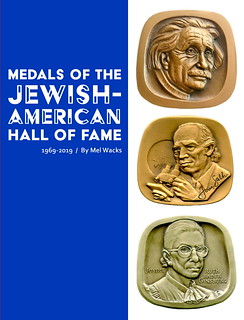 Pete Smith writes:
Pete Smith writes:
"There was an article last year that announced the end of the series of Jewish-American Hall of Fame medals. This was not mentioned in the announcement for the newest medal."
Thanks, Pete - fair question. I was hoping to include that reference, but had trouble finding the earlier article. The series did conclude in June 2024 but resumed again in October 2024 when a new medal maker was found. The old series medals were struck and the new medals are cast. I located the article this time and it's linked below. -Editor
To read the earlier E-Sylum articles, see:
JEWISH-AMERICAN HALL OF FAME MEDALS END
(https://www.coinbooks.org/v27/esylum_v27n22a24.html)
JEWISH-AMERICAN MEDAL SERIES REBOOTS
(https://www.coinbooks.org/v27/esylum_v27n43a32.html)
NEW MEDAL HONORS JULIUS ROSENWALD
(https://www.coinbooks.org/v28/esylum_v28n14a21.html)
Other topics this week include British North Borneo tokens, and hand-colored coin photos. -Editor
RUSTY GOE SPEAKS ON THE CARSON CITY MINT
Author Rusty Goe of Southgate Coins in Reno, NV gave a talk to a local audience last week about the Carson City Mint. Marie Goe wrote this article. Here's a lengthy excerpt, but see the complete article online for more images and Rusty's great limerick about the Mint. -Editor
Rusty Goe presented a talk on Saturday, April, 5, 2025, to a receptive audience of fifty people at Reno's Sierra View Library as a part of the Nevada Historical Society's Nevada History on the Go! program. After an introduction by the Historical Society's curator of history, Shery Hayes-Zorn, Rusty shared from his heart, using images to supplement his presentation, about events, people, and coins related to the Carson City Mint.
After sharing a story about Abraham Curry's receiving of an inscribed gold pocket watch from Carson City Mint employees, Rusty moved into his events
section during which he summarized how the Carson City Mint came into existence. Newspaper articles from the 1860s provided background material for his narrative.
DAHLONEGA MINT DOOR KNOCKER DONATED
The brass door knocker which once graced the Dahlonega Branch Mint building has been donated to the Hargrett Rare Book and Manuscript Library, The University of Georgia Libraries. -Editor
Knock, knock! This brass door knocker once welcomed visitors to the Dahlonega Branch Mint. Now, it has found a new home at the Hargrett Library!
Originally mounted on the Mint's front door in 1837, the knocker was recently donated by Susan King (pictured with Robert Harwell II), a descendant of Dr. Joseph J. Singleton—the Mint's first superintendent and treasurer. A small but mighty piece of Georgia's gold rush history!
BOSTON MUSEUM OF AMERICAN FINANCE OPENS
The Smithsonian-affiliated Museum of American Finance announced the signing of a ten year lease for a new exhibit headquarters in Boston. -Garrett
The Museum of American Finance, an affiliate of the Smithsonian Institution, announced it has signed a 10-year lease for exhibit space in Boston. Planning is now underway to develop and create the Museum's exhibits at Commonwealth Pier, the waterfront destination in Boston's Seaport being developed by Pembroke, the international real estate business. With a dynamic mix of new restaurants and shopping, a new waterfront plaza, an enhanced Harborwalk and year-round programming, Commonwealth Pier will be a vibrant waterfront destination for all.
The Museum will occupy approximately 5,400 sq ft, and exhibits are scheduled to open to the public on July 1, 2026. Entrance to all of the Museum's exhibits and programs in Boston will be free of charge—reflecting its core mission of making financial education accessible to all.
THE 2025 TRIAL OF THE PYX EXPERIENCE
The Trial of the Pyx, a ceremony that tests the quality of England's coinage and is one of the oldest judicial proceedings in the country, will occur on May 7. An exclusive Archive Experience will be held in the Library Reading Room. -Garrett
How much do you trust the coins in your pocket? In an age of digital finance coins are still reassuringly solid. This trust has been hard-won, thanks in no small part to the Trial of the Pyx – the annual test of the coins produced by the Royal Mint by the Goldsmiths' Company and the London Assay Office.
The 776-year-old ceremony, which is one of the UK's oldest judicial procedures, aims to protect consumers by upholding the quality of the nation's coinage through rigorous testing – as important today as it was at the first recorded public trial in 1248. The process ensures that the coins produced by The Royal Mint meet the standards of precision, accuracy and exceptional craftsmanship for which it is internationally renowned.
NUMISMASTER'S 2025 LONDON AND WALES TOUR
The folks at Numismaster are planning a trip to London and Wales, and you can join them! Here's the announcement. -Editor
 Join us on a tour of numismatic splendor in history-rich London and Wales. Immerse yourself in money of the past, present, and future as we visit museums, a coin shop, a coin show and a multitude of historical sites.
Join us on a tour of numismatic splendor in history-rich London and Wales. Immerse yourself in money of the past, present, and future as we visit museums, a coin shop, a coin show and a multitude of historical sites.
Tour Dates
September 3 – September 10, 2025
Tour Prices
$5,895 (USD) per person, double occupancy
$6,995 (USD) per person, single occupancy
Tour Includes
- All 4-star hotel accommodations
- All breakfasts, 3 lunches and 4 dinners
- Admission to all group destinations
- 2-course lunch at Royal Mint, Cardiff
- Comfortable coach transport
- Friendly & knowledgeable local tour guide
- Numismatic expertise of Numismatic News Senior Editor Sophia Mattimiro and Numismaster Pricing Analyst Jeff Starck
VOCABULARY TERM: REPLACEMENT MEDAL
Here's another entry from Dick Johnson's Encyclopedia of Coin and Medal Terminology. -Editor
Replacement Medal, Replacement Copy. A medallic item reissued or restruck to replace a previously issued medal which subsequently became lost or stolen. For military decorations the recipient, his agent, or sometimes a member of his family may be authorized to obtain such a copy. The medal may be drawn from stock if a quantity is on hand, or may require special striking, and/or engraving. Often a charge is made for such a second copy.
MILTON WALDO HANCHETT (1822-1904)
E-Sylum Feature Writer and American Numismatic Biographies author Pete Smith submitted this article on M. W. Hanchett, author of an obscure proposal for U.S. coinage designs. Thanks! Hanchett's proposal was a recent addition to my numismatic ephemera collection. -Editor
 M. W. Hanchett had a proposal for revisions to American coinage as well as a patent for the
sostenuto. To learn what that is, read on.
M. W. Hanchett had a proposal for revisions to American coinage as well as a patent for the
sostenuto. To learn what that is, read on.
Hanchett's American ancestors landed at Nantucket on May 30 in 1630. Milton Waldo Hanchett was born in Suffield, Connecticut, on July 12, 1822. His parents were Dr. John Wilkes Hanchett (1774-1844) and Margaretta Granger Hanchett (1790-1880). At the age of four, his family moved to Syracuse, New York, and settled there.
Milton's ancestry is complicated. Most people have two parents, four grandparents, eight great- grandparents, sixteen great-great-grandparents, and thirty-two great-great-great grandparents. Milton had only twenty-eight great-great-great grandparents. John Hanchett (1649-1744) and Esther Pritchard (1647-1711) were his great-great-great grandparents three times.
TREASURE TALK WITH BOB EVANS, EPISODE 3.1
In January, our good friend Bob Evans began publishing a series of blog articles on the Finest Known website detailing his experience as co-discoverer and curator of the treasures recovered from the wreck of the S.S. Central America. Subject of the book "Ship of Gold", many exhibits, countless interviews and articles, books and auction catalogs feature the legendary haul of gold coins, bars, nuggets, gold dust and more from the 1857 shipwreck. Here's another excerpt - see the complete article online.
It's very topical, as it turns out, showing how to provide proper evidence to U.S. Customs inspectors. -Editor
The morning of our Customs appointment, Brinks brought out the sturdiest 8-foot folding table they had and placed it in the middle of the locker room, surrounded by the banks of gray, half-height lockers. It looked like a 20-foot section of a public-school hallway, with a table set up for a bake sale. I filled out the paperwork to remove a dozen containers with an assortment of gold coins and ingots, figuring this would be a good start, and maybe all that was needed.
THE ARIZONA TERRITORIAL MINT
Heath White alerted me to a private mint that hadn't been on my radar - the Arizona Territorial Mint. Operated by Don Crowder, here's the company story from their website. -Editor
 Our business was established in 1961. I learned the trade from my father (Don J. Crowder). Being a Mint Master requires being an artist to draw up the concept of the idea for a coin, token, medallion, keychain, belt buckle, letter openers, sheriff badges etc. Next you must engrave the coining dies. Next you must be like a blacksmith to heat treat the coining dies. Then you must hand lap or polish the coining dies. You need the skill of a machinist to make the tooling that enables you to run or operate the big coining press.
Our business was established in 1961. I learned the trade from my father (Don J. Crowder). Being a Mint Master requires being an artist to draw up the concept of the idea for a coin, token, medallion, keychain, belt buckle, letter openers, sheriff badges etc. Next you must engrave the coining dies. Next you must be like a blacksmith to heat treat the coining dies. Then you must hand lap or polish the coining dies. You need the skill of a machinist to make the tooling that enables you to run or operate the big coining press.
The presses at the Arizona Territorial Mint came from the U.S. Mint at West Point circa (1893), that is the 400-ton hobbing press, the coining press that came from the U.S. Mint at Philadelphia circa (1861),is a 200-ton hobbing press, The U.S. Denver Mint circa (1908) is a 200-ton knuckle joint coining press, and the U.S. San Francisco Mint (1950) 100-ton screw press. All the U.S. Mint coining presses were badly worn-out or sold as scrap, to scrap or machinery dealers. I purchased the coining presses and restored them and got them up and running which took over thirty-five years of restoration. Today I use the presses daily. Yes, it takes a lot of maintenance to keep them running. These presses have made millions of silver dollars and twenty-dollar gold pieces. The coining presses over time have coined more than a billion dollars in coins.
HERITAGE AUCTIONS: BUST COINAGE
Heritage Auctions will be hosting their Bust Coinage Spotlight Auction on April 14. Select items are discussed below. -Garrett
1795 $1 Flowing Hair, Three Leaves, B-5, BB-27, R.1, XF40 PCGS. This is one of the top lots in the auction, and an excellent example of Flowing Hair coinage. It is the often seen B-5 variety, which is suitable for type collectors, as a nice coin can be had without breaking the budget to fulfill the demand of a scarce variety. This example is only lightly circulated, and it boasts a sharp strike with complete border dentils on each side. There are some adjustment marks (as struck) in the central obverse, which correspond to slight softness on the reverse eagle's breast. In my opinion, collectors could do far worse when seeking an XF 1795 Flowing Hair dollar.
SANTINI COLLECTION OF RENAISSANCE MEDALS
Stack's Bowers Executive Vice President Vicken Yegparian published this article about The Santini Collection of Renaissance Medals, which will be sold on April 15. -Garrett
As I sat down to write this, I was distracted by an email that popped into my inbox with the headline Renaissance Portrait Sets $3.1 Million Record.
Needless to say, the headline caught my attention, given the subject matter of this auction. The concept of the medal as we know it today had its origins in the Italian Renaissance, and though it had earlier antecedents, the medal was given its now familiar format by Italian Renaissance artist Antonio di Puccio Pisano, called Pisanello. Pisanello's medals have a very distinct style and format that can be identified from across the room, and many artists around the world have, with varying degrees of success, imitated that style over the centuries since Pisanello's first medals were cast.
EARLY AMERICAN HISTORY AUCTION APRIL 19, 2025
Here's the announcement for the upcoming April, 2025 sale by Early American History Auctions. -Editor
Early American History Auctions, Inc. is proud to announce the focus of this auction is the early history of America from the Colonial Period, French & Indian War, American Revolution, and the Civil War Era. Included are numerous diverse lots consigned by Ambassador and former Secretary of the Navy, J. William Middendorf II, highlighted by Paul Revere Engraved: THE BLOODY MASSACRE
Boston March 5th, 1770 & the historic engraving: THE BOSTONIANS IN DISTRESS
1775 .
NICOLAS MAIER MEDAL COLLECTION SELECTIONS
The medal collection of author Nicolas Maier is coming up for sale at MDC Monaco. He selected these lots which are among his personal favorites. Thank you - great medals. NOTE: the descriptions have been machine-translated from French to English. -Garrett
Nicolas Maier writes:
"One focus of my collecting activities was on pieces from the Société des Amis de la Médaille française (1899-1920) and depictions in the Art Nouveau and Art Deco styles. I was also very interested in unusual depictions such as Jouve's monkeys. I particularly like the following pieces."
Third Republic (1870–1940). Medal, La Toilette by Oscar Roty, SAMF No. 11, 1899, Paris. Maier 4; Bronze – 46.50 g – 69.5 mm – 12 h. Obverse: A young Greek woman from behind at her toilette; above, "ROME" and below, the signature "ROTY". Reverse: In the clouds, a lily branch and a mirror. Edge marks: (horn) BRONZE (lizard) and number 11. Only 171 examples struck in bronze and distributed to members of the Société des Amis de la Médaille Française (SAMF). With a glossy brown patina, barely rubbed on the buttock and shoulder. Superb, as struck.
From the collection of Nicolas Maier.
To read the complete item description, see:
Third Republic (1870–1940). Medal, La Toilette by Oscar Roty, SAMF No. 11, 1899, Paris.
(https://www.biddr.com/auctions/mdcmonaco/browse?a=5671&l=6963359)
HUNTINGTON COLLECTION TO BE SOLD AGAIN
NOTE: After publication we learned that the article we based this one on was outdated, resurfacing after having been published in 2012. -Editor
Ed Hohertz writes:
"Some readers may find it interesting that the Huntington Collection of 38,000 pieces could not find a buyer for the single lot. It has now been sold to a consortium that will separate the lot and offer it in separate auctions."
Thanks for the follow-up. Here's a Google-translated excerpt from the article. -Editor
The Hispanic Society's former coin collection, auctioned by Sotheby's a few months ago, will be sold in lots in Europe. Three of them, auctioned individually in an open bidding process, will be available for purchase in Madrid.
THE MARYLAND GUNPOWDER NOTES
Stack's Bowers Galleries' Currency Specialist & Lead Currency Cataloger Bradley Charles Trotter published this blog article about Maryland's Gunpowder
notes.
-Editor
By far one of the distinctive issues of the colonial period, Maryland's Gunpowder
notes are a window into both revolutionary sentiments and the measures taken amidst uncertainty and conflict. Issued under a resolve dated July 26, 1775, these notes were intended to promote the manufacture of gunpowder. They offer a far more distinctive composition than the simplistic forms favored by Maryland during the period.
At left, as part of a design produced by Thomas Sparrow, George III oversees the burning and occupation of an American city from a symbolic distance. The balance of the composition harkens to the possibility that peace and reconciliation could be achieved between the Colonies and Great Britain. A female allegorical figure representative of the Continental Congress hands Britannia a petition labeled CONG PETI, while American troops carrying the flag of Liberty are seen in the background.
AUSTRALIAN MONARCHISTS WANT CHARLES NOTE
Australian monarchists are lobbying for a banknote design featuring King Charles III. -Editor
In 2023, the RBA announced it would be replacing the nation's longest reigning monarch with a design that celebrates the connection that First Nations peoples have to Country
.
On Tuesday, The Australian Monarchist League (AML) revealed a compromise design that pays tribute to both Indigenous Australians and maintains the tradition of featuring the Monarch on the banknote.
WWII POLAND COUNTERFEITING PLATE FOUND
A WWII-era lithographic plate for counterfeiting Polish banknotes was recently discovered in Warsaw. -Editor
A matrix used to produce counterfeit banknotes during World War II has been discovered during renovation work at one of Warsaw's most famous banks.
The device was found concealed beneath wooden flooring inside the National Development Bank (BGK) building in the city center and had most likely been there since wartime.
Featuring the mirror image of a one zloty banknote, the lithographic plate had been created on a perfectly flat slab of marble measuring 18 by 19 centimeters.
SLABBING MISCUE: PRUSMACK VS. J.S.G. BOGGS
As a collector of the artwork of my old friend J.S.G. Boggs I keep an eye out in the marketplace for new offerings. This eBay lot caught my eye as a Boggs work I hadn't seen before. -Editor
Explore the unique world of alternative currency with the J.S.G. Boggs Art Note. This $2 non-Legal Tender Note is a legacy of artistic innovation, featuring distinctive drawings by the renowned artist J.S.G. Boggs. Its vivid theme of art is presented on high-quality paper, ensuring that each piece captures the essence of Boggs's vision.
Each note is a testament to the rich history of currency and art, making it a must-have for collectors and enthusiasts alike. With its Very Fine-35 (VF-35) grading, this item showcases its preservation and quality, promising to be a valued addition to any collection.
LOOSE CHANGE: APRIL 13, 2025
Here are some additional items in the media this week that may be of interest. -Editor
In the first quarter of 2025, the Philadelphia and Denver Mints have produced nearly 650 million cents. But they're preparing to wind down, working through existing supplies of cent blanks and no longer ordering more. Here's an excerpt from a recent Coin World report. -Editor
 Legislation introduced in the 119th Congress would specifically limit production of the Lincoln cent, a coin that has been struck for nearly 116 years since its introduction in 1909.
Legislation introduced in the 119th Congress would specifically limit production of the Lincoln cent, a coin that has been struck for nearly 116 years since its introduction in 1909.
The inventory of unstruck ready-to-strike cent planchets combined at the Denver and Philadelphia Mints is considered by the Federal Reserve and the U.S. Mint enough to handle production needs for the near future as the mintages wind down, with no more planchets ordered from the lone outside vendor.
The unstruck planchets are also sufficient for striking Uncirculated Lincolns cents at the Philadelphia and Denver Mints for inclusion in 2025 Uncirculated Mint sets and for Proof sets executed at the San Francisco Mint.
The ready-to-strike planchets with raised rims have been produced for decades by the same contracted outside vendor in Tennessee. The vendor has undergone several name changes — Alltrista Corp. in Greeneville, Jarden Zinc Products at the same location in Greeneville, and now Artazn LLC, as a subsidiary of One Rock Capital in Tusculum, Tennessee.
To read the complete article, see:
Planchet supply is enough to keep the cent in production
(https://www.coinworld.com/news/us-coins/planchet-supply-is-enough-to-keep-the-cent-in-production)
To read the earlier E-Sylum articles, see:
THE PENNY PURGE: COMMON CENTS OR CENTSLESS?
(https://www.coinbooks.org/v28/esylum_v28n07a29.html)
Other topics this week include 2025 Proof Set Sales, and a coin exhibit in India. -Editor
THROWING BANKNOTES IS ASSAULT
In the no-really-it's-ok-assault-me department, it's apparently illegal to throw banknotes at someone in South Korea. I'm not in South Korea, so fire away. Big bills preferred. -Editor
 A court rejected an appeal from a man accused of throwing a stack of banknotes in a motel employee's face, ruling that the act amounted to assault under Korean law.
A court rejected an appeal from a man accused of throwing a stack of banknotes in a motel employee's face, ruling that the act amounted to assault under Korean law.
The man in his 30s had been fined 500,000 won ($350) for throwing eight 50,000 won bills at an employee in the parking lot of a motel in Suwon, Gyeonggi, in January 2023.
The man attempted to park on the way to meet his girlfriend, but the motel worker told him that only guests with premium rooms could use the lot. The defendant allegedly threw the stack of bills directly at the employee's face after an argument.
FEATURED WEBSITE: ARIZONA TERRITORIAL MINT
This week's Featured Website is the Arizona Territorial Mint of Cove Creek, AZ, suggested by Heath White.
Arizona Territorial Mint provides minting services such as art work created sculpting, 2D - two dimensional, 3D - three dimensional and edge marking. We use a variety of metals including copper, brass, nickel silver, coin silver, sterling silver, .999 silver, karat gold, .999 gold and platinum. Our finishes include bullion, proof-like, frosted, antiqued and silver & gold plated. Our quality and attention to detail is unsurpassed and sets us apart. Everything is made in house.
https://www.atmint.us/
ABOUT THIS ISSUE: APRIL 13, 2025
Kurt Vonnegut quote I came across this week: "True terror is to wake up one morning and discover that your high school class is running the country."
Learning about M. W. Hanchett's complicated ancestry I almost expected Pete Smith to quote the lyrics of "I'm My Own Grandpa".
I also made some plans for next month's PAN show, where I'll be sharing a banquet table with old friends Ben Costello and Bob Evans. -Editor

